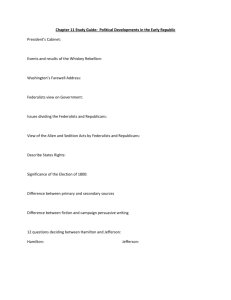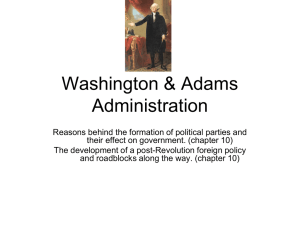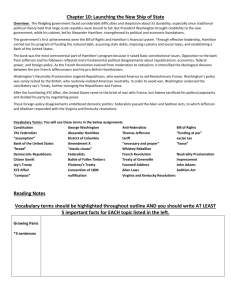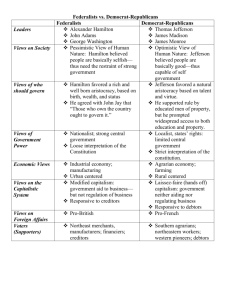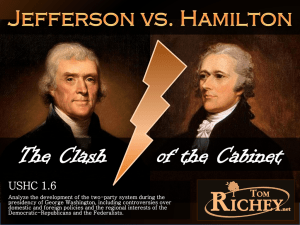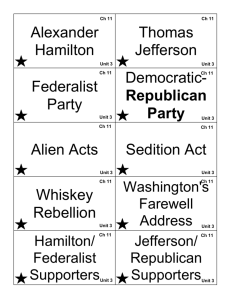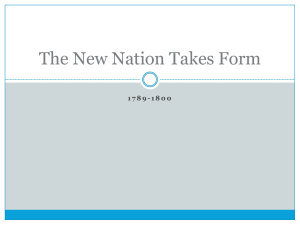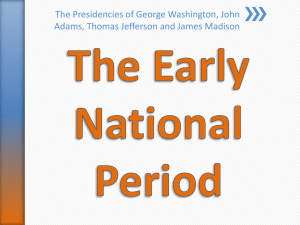Chapter
advertisement
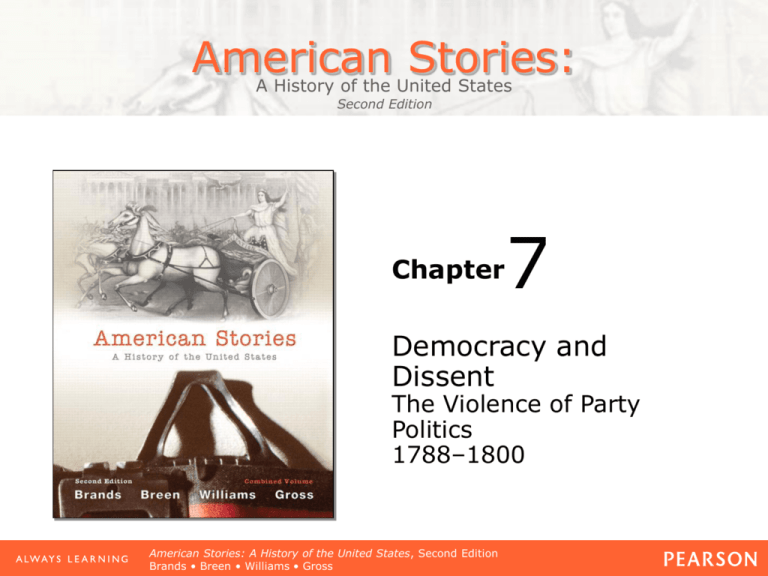
American Stories: A History of the United States Second Edition Chapter 7 Democracy and Dissent The Violence of Party Politics 1788–1800 American Stories: A History of the United States, Second Edition Brands • Breen • Williams • Gross The Hero of Trenton Well-wishers spread flowers in front of George Washington as he rides through Trenton, New Jersey, on his way from Virginia to New York for his inauguration as the first president of the United States in 1789. Democracy and Dissent 1788–1800 • Principle and Pragmatism: Establishing a New Government • Hamilton’s Plan for Prosperity and Security • Charges of Treason: The Battle Over Foreign Affairs • Popular Political Culture • The Adams Presidency: Politics of Mistrust Force of Public Opinion • Root cause of political parties: ambiguity of republican ideology • Federalists (Hamiltonians) Rapid integration into world economy Distrusted common man Strong national institutions Force of Public Opinion (cont’d) • Republicans (Jeffersonians) Faith in white yeoman farmers With no government intrusion, they could retain virtue and resist crass materialism • New dynamic public opinion Average people no longer deferred to their social “betters” Principle and Pragmatism: Establishing a New Government Principle and Pragmatism: Establishing a New Government • George Washington unanimously elected president, 1788 • John Adams elected vice president Getting Started • Washington’s skilled use of symbols of power were key to his presidential success Grand tours 1789, 1791 • Congress established three executive departments: War, State, and Treasury Getting Started (cont’d) • Judiciary Act of 1789 established Supreme Court and thirteen District Courts • 1789—5% tariff levied to fund government Conflicting Visions: Jefferson and Hamilton • Jefferson—Secretary of state under Washington • Believed limited government preserves liberty, against large debt • Hamilton—Secretary of Treasury • Believed strong central government preserves independence, feared anarchy more than tyranny Hamilton’s Plan for Prosperity and Security Hamilton’s Plan for Prosperity and Security • Congress asked Hamilton for suggestions for solutions to debt problem • He produced three reports Public Credit Banking Manufacturers Hamilton’s Plan for Prosperity and Security (cont’d) • Debt of $54 million, additional state debt of $25 million • 80% of debt held by speculators Debt as a Source of National Strength • Report on the Public Credit – recommendations Fund obligations at full value Federal government to pay states’ debts • His plans loudly criticized But assumption passes Interpreting the Constitution: The Bank Controversy • National bank privately owned, partly funded by federal government • Opposed because it might “perpetuate a large monied interest” • Jefferson opposed it as unconstitutional Interpreting the Constitution: The Bank Controversy (cont’d) • Hamilton defended constitutionality through doctrine of “implied powers” • Congress chartered bank, 1791 • Fed perception that Hamilton was bringing corrupt British system to America Setback for Hamilton • Report on Manufacturing (1791) sought federal encouragement for manufacturing Protective tariffs and industrial bounties • Madison warned that program would strengthen federal government at state expense Setback for Hamilton (cont’d) • Jefferson warned that the rise of cities would destroy agriculture and agrarian civic virtue • Southerners opposed to protective tariffs • Hamilton’s recommendations defeated Charges of Treason: The Battle Over Foreign Affairs Charges of Treason: The Battle Over Foreign Affairs • French Revolutionary Wars shaped U.S. political divisions • Jeffersonian Republicans Favored France States’ rights Strict interpretation of the Constitution Charges of Treason: The Battle over Foreign Affairs (cont’d) • Hamiltonian Federalists Favored England Strong central government and economic planning Maintenance of order by federal troops The Peril of Neutrality • British still occupied Ohio River Valley and discriminated against American trade • Franco-British War broke out, 1793 Execution of Louis XVI The execution of the king by French revolutionaries deepened the growing political division in America. Although they deplored the excesses of the Reign of Terror, Jeffersonian Republicans continued to support the French people. Federalists feared that the violence and lawlessness would spread to the United States. The Peril of Neutrality (cont’d) • England violated American sovereignty and neutrality on high seas Jefferson: punish England by cutting off trade Hamilton: appease England because too strong • French diplomat Edmond Genet challenged American neutrality repeatedly in public Jay’s Treaty Sparks Domestic Unrest • John Jay to England to demand: Removal of English from America Payment for ships illegally seized Better commercial relations Jay’s Treaty Sparks Domestic Unrest (cont’d) • Hamilton informed English U.S. would compromise; no concessions won • Newspapers, Republicans attack treaty; criticized Washington • Bitter partisan division Pushing the Native Americans Aside • British encouraged Indian attacks • Treaty of Greenville (1794)—forced Indian removal from Ohio; British withdrew support from Indians Pushing the Native Americans Aside (cont’d) • Spain closed Mississippi River to Americans • Treaty of San Lorenzo • Spanish opened Mississippi Settled disputed border between Florida and U.S. Spanish ceased inciting Indians against settlers Popular Political Culture Map 7.1 Conquest of the West Withdrawal of the British, defeat of Native Americans, and negotiations with Spain secured the nation’s frontiers. Popular Political Culture • Political “parties” condemned as factions • Widespread concern over loss of common revolutionary purpose • Federalists and Republicans suspected each others’ loyalty • Party members thought it a patriotic duty to destroy opposing party Whiskey Rebellion: Charges of Republican Conspiracy Excise tax on whiskey imposed 1791 1794—Pennsylvania farmers protested Republican governor refused to act Federalists interpreted as Republican conspiracy • Washington and Hamilton led 15,000man army to crush the rebellion • • • • Whiskey Rebellion: Charges of Republican Conspiracy (cont’d) • Rebels could not be found • Washington blamed Republican clubs for encouraging unrest • Jefferson saw it as excuse to raise army to intimidate opposition Washington’s Farewell • Washington increasingly sympathetic to Federalists • Fall 1796—Washington released Farewell Address, written by Hamilton • Announcement timed to prevent Republican organization of presidential campaign • Warned against permanent “foreign entanglements” The Whiskey Rebellion Tarring and feathering federal officials was one way western Pennsylvanians protested the tax on whiskey in 1794. Washington’s call for troops to put down the insurrection drew more volunteers than he had been able to raise during most of the Revolution. (Source: Whiskey Rebellion, c. 1790s, handcolored woodcut/North Wind Picture Archives.) The Adams Presidency: Politics of Mistrust The Adams Presidency: Politics of Mistrust • Bitterly divisive election in 1796 • Federalists divided, Hamilton tried to push Pinckney over Adams • Adams forced to accept people not supportive in cabinet Republican Jefferson is vice-president Federalist Department heads more loyal to Hamilton than Adams The XYZ Affair and Domestic Politics • Jay’s Treaty prompted France to treat U.S. as unfriendly nation • Quasi-war: French seized U.S. ships • Diplomatic mission failed when three French officials (X, Y, and Z) demanded bribe TABLE 7.1 The Election of 1796 The XYZ Affair and Domestic Politics (cont’d) • Provoked anti-French outrage in U.S. • Federalists attempted to crush Republicans by branding as pro-French President Adams John Adams in the suit and sword he wore for his 1797 inauguration. The portrait is by English artist William Winstanley, 1798. Crushing Political Dissent • Federalists began building up the army Ostensible purpose: repel French invasion Actual intention: stifle internal opposition • Hamilton commanded army, controlled officers Crushing Political Dissent (cont’d) • Hamilton sought declaration of war against France to begin operations against dissent • Adams created navy, refused to ask Congress for war Silencing Political Opposition: The Alien and Sedition Acts • Alien and Sedition Acts Purpose to silence Republicans First civil liberties crisis • Alien Enemies Act and Alien Act gave the president power to expel any foreigner • The Naturalization Act required U.S. residency of fourteen years for citizenship Party Conflict In the early years of the republic, political dissent sometimes escalated to physical violence. This fistfight took place on the floor of Congress, February 15, 1798. The combatants are Republican Matthew Lyon and Federalist Roger Griswold. Silencing Political Opposition: The Alien and Sedition Acts (cont’d) • Sedition Act criminalized criticism of the government • Federalist appointees in federal courts enforced Sedition Act in absurd ways Republican Congressman Mathew Lyon arrested, won re-election from jail Kentucky and Virginia Resolutions • Republicans saw Alien and Sedition Acts as dire threat to liberty • Virginia and Kentucky Resolutions said states have final say in determining constitutionality of federal law Jefferson’s Kentucky Resolutions—states may nullify unconstitutional federal law Madison’s Virginia Resolutions—urged states to protect their citizens Kentucky and Virginia Resolutions (cont’d) • Purpose of resolutions: clarify differences between Republicans and Federalists, not justify secession Adams’s Finest Hour • 1799—Adams broke with Hamilton • Sent new team to negotiate with France • War hysteria against France vanished Adams’s Finest Hour (cont’d) • Hamilton’s army seen as a useless expense • Convention of Mortefontaine No compensation for seized American ships 1778 treaties null and void French restrictions on U.S. commerce removed Created climate of trust between France and U.S. The Peaceful Revolution: The Election of 1800 • Federalists lost, but Republicans Jefferson and Burr tied • Lame duck Federalist House of Representatives would break the tie The Peaceful Revolution: The Election of 1800 (cont’d) • 12th Amendment separated votes for president and vice-president to avoid repeat of this situation • Adams and the “midnight judges” • Jefferson’s inaugural: “we are all republicans, we are all federalists” TABLE 7.2 The Election of 1800 Conclusion: Danger of Political Extremism Conclusion: Danger of Political Extremism • Election of 1800 one of the most important • Transfer of power from Federalists to Republicans achieved peacefully • Nation averted ideological civil war Timeline
